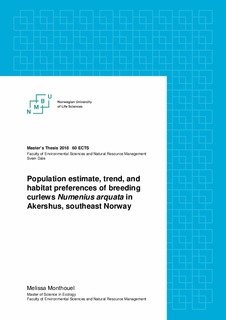Population estimate, trend and habitat preferences of breeding curlews (Numenius arquata) in Akershus, southeast Norway
Master thesis
Submitted version

View/
Date
2018Metadata
Show full item recordCollections
- Master’s theses (MINA) [668]
Abstract
The Eurasian Curlew (Numenius arquata) is a species in decline, classified as near threatened (NT) worldwide, and vulnerable (VU) in Norway. In the region of Akershus (SE Norway), no recent update exists of the breeding population trend. I examined how curlews selected their habitats in Akershus, how the population size changed in the period 1971-2017, and how important natural bogs are for them. Curlews selected medium vegetation height (10-20 cm) and stubble and tended to avoid tilled fields. 28-30 pairs were recorded in Akershus in 2017, the population declining by 40% in the last 23 years. Curlews tended to decline less in lowlands territories than in uplands territories and on sites within 1 to 5 km from a bog. Curlews most likely preferred medium vegetation height as it provides shelter from predators and good foraging habitat and avoid dry tilled fields because of poor food availability and exposure to predators. Habitat changes in agricultural landscapes, agriculture intensification, and increase of predators such as corvids and foxes are possible causes of the decline.
